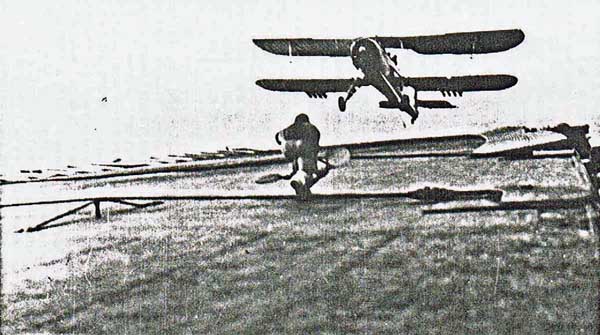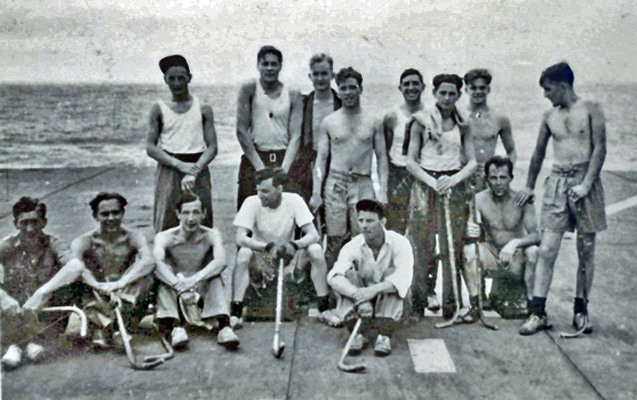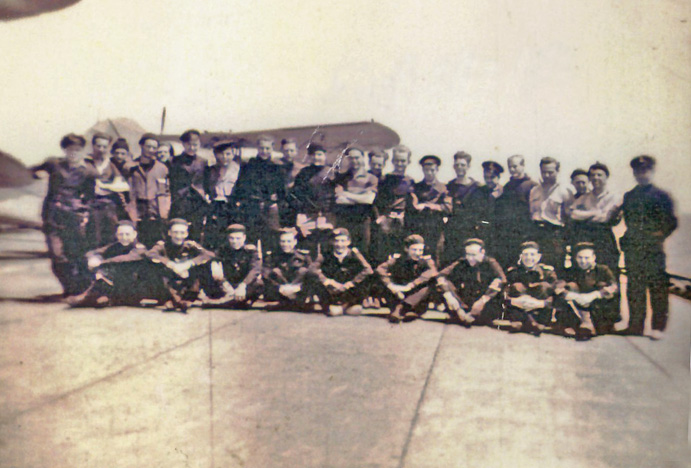|
Interaction between FAA and Merchant Navy
personnel
|
|
To
comply with the Geneva Convention all the R.N. personnel had to sign on as
deck hands or officers in the Ben Line at one shilling a month (nominal)
and a bottle of beer a day (which we got).Board of Trade specifications
meant that the accommodation was more spacious than on Fleet Carriers,
particularly on the Lower Deck where bunks rather than hammocks were the
order of the night. But though we were all to sail under the Red Duster as
men of the Ben Line, Macalpine was home to two differing seafaring
traditions between which there existed not only rivalries but
recriminations. The differing traditions very obvious if only in the
conditions of work; for while most or the M.N.men worked to Union hours
and rules with overtime for evenings and weekends, our Squadron personnel
were available all hours in all weathers. But on Macalpine, the keynote
was cooperation and both traditions, unified under Ben Line status, joined
together to make Macalpine a happy and efficient ship. Getting on with the
M.N. was not an end in itself but a means to a larger end: the defence of
convoys and those who sailed them against the U-boat menace which had cost
the Allies so much in lives and goods in the early years of the war.
|
|
836 squadron objectives |
|
It
was intended eventually to sail one or two Macships with every convoy.
This would provide close cover from the U-boat threat, it would guarantee
every convoy air cover across the entire Atlantic,and would give freer
rein to shore based aircraft and anti-submarine Escort Groups to seek out and
attack submarines on their way to and from convoys and intensify their
attacks on U-boat and Wolf-packs lying in wait to attack convoys. So 836
became, and was for the rest of the war, committed to the battle of the
Atlantic
and the aircrews who pioneered the first two voyages of Macalpine would
become Flight Leaders of the many sub-flights which made up 836. By the
end of the war 836, with over 90 aircrew, was the largest squadron in the
FAA.
|
|
Early landings on MV Macalpine |
|
The
first the Squadron saw of Macalpine was on 7 May when Ransford made the
first landing with Jim Palmer and P.O. Robertson as crew. By the end of
the day he had completed nine landings. At 1530 he flew the 5th Sea Lord
(Admiral Boyd) to Machrihanish (having disappeared below the flight deck
level on take-off), collected the other pilots who made their first
landings (solo), and did 'circuits and bumps' with varying loads of depth
charge armament before returning to Machrihanish. On the 8th a howling
gale prevented flying, but on the 9th Ransford landed in a 45 knot wind.
On the 14th after Ransford had completed another eight deck landings (one
when with two depth charges on board and his arrester hook torn out by the
edge of the lift - accidentally slightly open - he landed on his brakes)
the Squadron landed on.
|
|
Landing
on M.V.Macalpine- Swordfish going round again-photo from Phil Blakey |
 |
|
First deck landings for Observers |
|
For
some Observers Macalpine was the first experience of deck landing. It was
a peculiar sensation to be entirely in the pilot's hands, powerless to
adjust to the heaving fast-approaching deck and knowing that one was about
to go from 40/50 knots to STOP in the space of a second. / recorded at the
time that on our approach, attached to the aircraft by my ‘monkey
strop’ (some called it a G-string) I braced myself for the inevitable, a
marvellous double-entendre line from Sullivan's ‘Crossing the bar’
passed through my mind: ‘I hope to see my Pilot face to face when I have
passed the bar’. But these new experiences merely added to the
confidence between Observer ‘I'll get us back to base’ and Pilot
‘I'll get us down safely’. There followed days in the
Clyde
testing equipment, radio, radar, speeds. Sometimes we moored off Rothesay
or Gourock after a day's trials and there were frequent trips ashore to
Gourock -
Greenock
for stores or spares or dances. These trips in the duty drifter from
Gourock pier sometimes took us no further then the Bay Hotel where beer
was 1/3d a pint! Pilots had reported that as they made their landing runs
over the round down, they felt their aircraft lifted, spoiling their
approaches to the deck. As a result the offending galley chimney which had
exuded the upward draught had to be repositioned A wooden extension was
constructed at the stern end of the flight deck so as to increase the
length available For take-off otherwise the flight deck would effectively
have been reduced by the length of the Swordfish; this was another
modification. Even with fine-pitch propellers for extra lift, every inch
as valuable especially if there was no wind blowing and the ship at
maximum speed was producing a mere 12 knots of wind speed over the deck.
To ensure no unnecessary weight was carried the front and rear runs were
removed, and it was sometimes necessary to leave parachutes and T/air
gunner behind in favour of depth charges
.
|
|
M.V.Macalpine
approaching Halifax, Canada-lift going down. Photo from Phil Blakey |
 |
|
Take off & Landing Training |
|
Most
important was the training and practice in flying off and landing on as
quickly as possible so as to minimise the time the ship had to sail into
wind to operate its aircraft. At sea in convoy it was planned to operate
take-off and landing within the perimeter of the convoy and escort, so
time would be of the essence especially if the wind were ahead of the
convoy. So aircraft B had to be in position to land as soon as A's
take-off slip stream had stabilised; deck crew had to look lively to
unhook the aircraft, get it down on the lift and have the lift up in time
for 'C' to land.‘Bats’ Singleton and the Pilots (three of whom had
carrier experience) quickly struck up the necessary rapport and it was
here that Owen Johnstone, the new boy with the natural instincts of a
fighter pilot, produced his special technique, swishing in from port
quarter at sea level and swinging in what some called a 'split arse turn'
in position to receive instructions from 'Bats'.Inspite of inexperience
there were no accidents landing during the whole of our trials.
|
|
Observers Training |
|
The
Observers were far from idle, checking the compasses and keeping an eye on
the ASV serviceability, and practising weather forecasting. They'd been
given a crash coarse in meteorology and weather codes for use at sea and
decisions to fly or not would be based on what they forecast So in the
quiet of the night the 'Duty boy' would go to the Snarks' office and take
down the Morse-coded weather reports, decode the Morse and translate into
met. Code, and plot the fronts, troughs and ridges on the north Atlantic
map. In convoy the forecast was passed to the Commodore and Senior Officer
Escort. There were often red faces for different emotions on the three
ships involved.
|
|
Slater's leadership |
|
In
these compressed weeks of training aboard Macalpine, Ransford Slater was
in his element. Leadership was evident in every aspect. His skill in
unlocking the secrets of how to land on so small a deck and passing them
on to his pilots, the care he took to see that the ‘troops’ morale was
good and to make them feel that their contribution to the success of the
enterprise was vital, and generating a real enthusiasm about the work we
were doing. Not least important was his insistence that RN/MN barriers be
broken down. The 'Royal Navy' logo an the Swordfish was replaced by
'Merchant Navy', the ship’s call sign was 'Dearsden', the home of
Captain Riddle, and the aircraft given call signs Riddle Able, Riddle
Baker, and so on. Later 'B' Flight aircraft were named after the ships of
the Ben Line. The Squadron replaced naval caps with M.N. berets. Phil
Blakey was encouraged to follow his engineering bent with the Chief
Engineer and his Doxfords and listened to Chiefy's laments about the
tension on the arrester wires.
|
|
Doc "Hawkeye" Kearns |
|
Doc
Kearns
made himself master of the anemometer and treated M.N. and R.N.. ‘sick,
lame and lazy’ in a fine sick bay which in retrospect had much of the
air of Hawkeye's tent in M.A.S.H. John Taylor was encouraged (at first) to
learn the ukulele and could soon accompany Ransford in his parody of an
old rugby song:
|
|
|
O we are the fighting Macships
It's at the bar you'll always spot 'em
Our motto is never let up
And to brass hats and bullshit
God rot
'em |
|
|
Personnel on M.V.Macalpine |
|
The
song had all the flavour of Ransford's iconoclasm and irreverence for red
tape and ‘bull’ which we had seen particularly at Machrihanish. As a
Dartmouth
product he never forgot he was R.N., but his approach to achieving the
right tone in cooperation was just right. It was highly successful, with
Capt. Riddle's enthusiasm and good humour, in blending us into one ship's
company. And if we were asked to make cooperation a priority, no-one was
asked to unbend beyond his natural bent, so to speak. Lt.Cdr. 'Tug'
Wilson
as A.S.O. and carrier of the final can while encouraging most if not all
that went on had of necessity to keep the 'reserve' proper to the Senior
Naval Officer aboard. He had already laid the foundations with Capt.
Riddle back in Burntisland one evening, and like the rest of us had signed
on with the Ben Line. He would take part in Bridge and Uckers (Ludo)
contests and be beaten in the final of the latter by the champion - John
Taylor. In truth all contributed to the cooperative enterprise on Empire
Macalpine, and in turn the same spirit was conveyed to the succeeding
grain and oil tankers which went into service later.
|
|
Captain William Riddle |
|
But
over all there presided the commanding figure of CaptainWilliam Riddle. He
was responsible for the safety of the ship and its cargo. He was
responsible for the handling of the ship when operating its aircraft or in
convoy position, and he was responsible for both .R N. and H.N.personnel
aboard and for the harmonious relations between them; a big man in every
way. He set a marvellous example; one can still visualise him leaning over
the bridge, a bulky figure with cloth peaked cap, smiling proudly and
looking as if he'd been operating aircraft carriers all his life. He
had in fact long connections with the R.N.. Born in 1882 the son of a
Provost of Galashields, William Riddle joined the R.N. at the age of 15
and trained under sail, rising to full Lieutenant. He left the Navy in
1911 to be near his wife who died from Bright’s disease in1913.In 1914
he enlisted in the army but in view of his naval career was
transferred to the R.N. in which he served till 1920. Seeing no
immediate hope of promotion, he joined the Merchant Service in the Ben
Line. He was Master of the Bencruachan from 1928 to 1941, when the ship
was mined and sunk off
Alexandria
. Captain Riddle was in hospital with injuries which included a broken
leg, and after a long recuperation was given command of M.V.Macalpine
and
watched her being built at Burntisland.
|
|
So
that with his wide experience of ships and the sea in both services and
his experience of command in war and peace, he was the ideal choice for
this new venture. A brilliant raconteur and bridge player, he was a lively
and entertaining visitor to the Mess when time permitted. Tug
Wilson
recalls the Captain's tale of being accosted on him way back to the ship
in Burntisland by a well-dressed lady offering overnight accommodation -
for a price. Captain Riddle, in civilian clothes and hardly able to
suppress his amusement, boldly offered 2/6d. "Half a crown" the
lady snorted "and me with a hat on". Captain Riddle immediately
had the respect of naval personnel, and he in turn had almost a fatherly
feeling for his young flyers. He richly deserved the O.B.E. which he was
awarded in 1944 for his work in pioneering the Macships.
|
|
Deck Hockey - photo from Phil Blakey
|
 |
|
ONS 9 |
|
On 28th May 1943 we left the Clyde and soon the contingents of ONS 9
from Liverpool, Loch Ewe and the Clyde, joined what we believed would be
a perilous and exciting Atlantic crossing. Our role was defensive.
Perhaps it was perceived that Atlantic conditions could restrict the
possibilities of flying from such a small base or lead to unacceptable
levels of accidents which would leave no serviceable aircraft when under
attack: or that too frequent manoeuvring of the Macships within the
perimeter of the convoy might increase the risk of collision. We would
fly dawn and dusk patrols (weather permitting) and fly off in any
weather on receipt of a U-boat contact. But the accent was on defence
against actual attack. Perhaps Macships were seen merely as an advance
on CAM ships in that the aircraft defending the convoy were retrievable
and not, as in the case of the Hurricanes from CAM ships, expendable,
but it was soon discovered that Macships could provide almost continuous
cover when later Owen Johnstone in G Flight, flying from Ancylus did the
night flying trials which instigated night ops from Macships. |
|
To
our great surprise our maiden voyage was a quiet one. In view of the
fierce onslaught by the U-boats in inn winter and spring of 1942/3 we were
expecting the Wolf pack attacks which had been the mainspring of U-boat
successes of those months. Consequently we had our routines with duty
crews at ready in the Ops room and relevant information - weather,
identification - kept up to date. But unbeknown to us, in view of the loss
of 40 U-boats in May 1943 Admiral Doenitz had ordered all U-boats to leave
the
Atlantic
on the 24th - four days before we sailed. Thus, in view of our defensive
role there was much less flying on this trip than in later days but there
was work to be done, locating stragglers and increasingly mounting patrols
to achieve our objective - the safe arrival in
Halifax
of the convoy's forty ships. So the daily routines kept us busy - daily
inspections of the aircraft, plotting the convoy's progress, forecasting
the weather, maintaining equipment, Navexes, and helping the ‘troops’
in preparation for tests for promotion.
|
|
The
first operational sortie from Macalpine was flown by Johnstone-Taylor in H
for Howe (previously Harry). It almost ended in farce. Expecting U-boat
packs to lie in wait, three small vessels were sighted at 0500 hours at
the end of a patrol in cloud and rain, so we dodged into cloud to shadow
and reported what appeared to be three U-boats in company approaching the
convoy. When we came out of the cloud we discovered we were over three
escort vessels looking for ONS 9. They asked us for directions, which we
gave. Fortunately the 1304 R/T set on which we had reported the
‘enemy’ was not working, so our blushes were spared. But we on
Macalpine had had no warning to expect three escort vessels, so
perhaps, in view of the fate of so many convoys our mistake was
understandable. These dawn patrols were preceded by large draughts of
‘Pusser’s sludge’ - a naval concoction made from sugar, cocoa and
condensed milk, stirred into a sludge with hot water. It certainly kept
the cold out in the air on the bridge.
|
|
|



|


